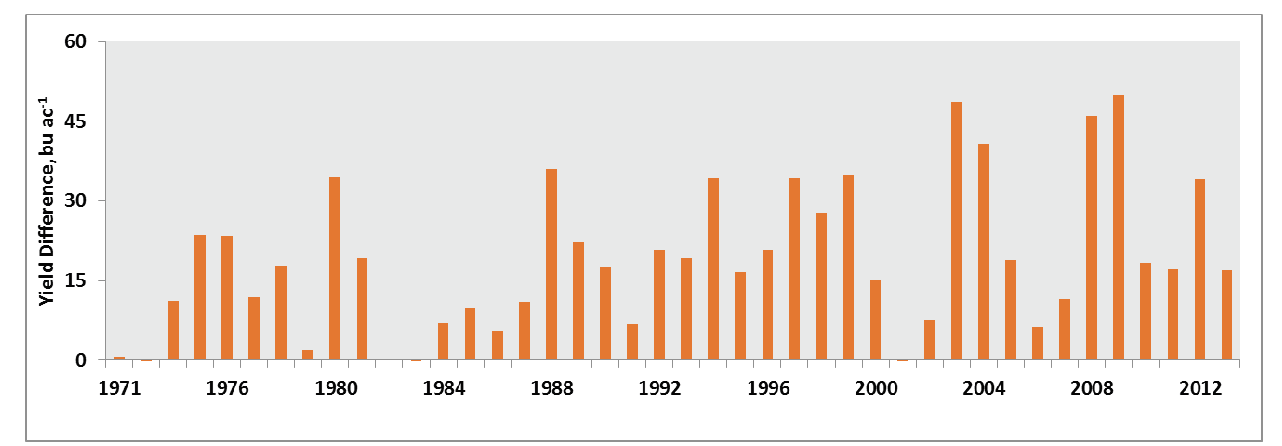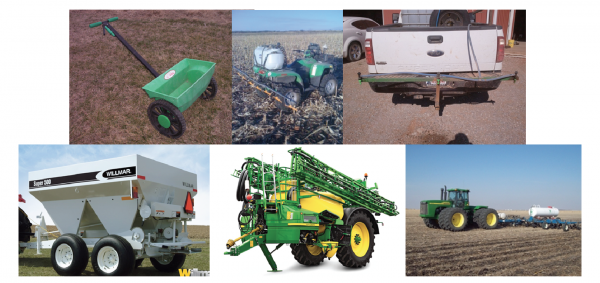Applying Nitrogen-Rich Strips
A crop’s demand for fertilizer nitrogen varies annually, even in long-term plots where the same fertilizer nitrogen (N) rates are applied each year. Long-term soil fertility experiments at Lahoma have revealed the average N fertilizer requirement for wheat is 2 pounds of nitrogen per bushel. However, examining individual years reveals a wide range in the response of wheat grain yield to N fertilizer. Figure 1 shows the difference in yield between check plots that have not received any N since the trial was established more than 40 years ago, and plots that have received 100 pounds of nitrogen every year. In 1973, 1979, 1983 and 2001, the non-fertilized plots produced the same yields as those fertilized. In years when no fertilizer response was observed, the yields ranged between 28 bu ac-1 and 40 bu ac-1. In comparison, nitrogen fertilizer increased yields by 35 bu ac-1 or more in 1988, 1997, 2003, 2004, 2008, 2009 and 2012. The average yield of the fertilized plots during those seven N-response-years was 69 bu ac-1.
Figure 1. Wheat grain yield difference between plots that received 100 lbs N per acre every year and the 0-N check. Data from the 502 long term fertility study, which was established in 1971, located at the North Central Research Station near Lahoma, OK.
Where did the N come from in the years where the non-fertilized plots did as well as plots that had been fertilized yearly for nearly 40 years? The answer is N mineralization via an extremely wet and warm winter-spring. When winters are wet and warm, sufficient N can be mineralized from soil organic matter to meet the demands for high grain yield. In addition to this mineralization, wet years have more N deposition from rainfall. Our long-term winter wheat data confirm that the demand for N varies from year to year and wheat grain yield response to nitrogen fertilizer is unpredictable at the time when pre-plant N is being applied.
If the optimal nitrogen fertilization rate changes each year, how can a farmer accurately
calculate the correct amount of nitrogen fertilizer to apply? Soil testing (NH4-N and NO3-N) works well, but a pre-plant soil test does not give you all the information you
need to make the most precise mid-season N rate decision. Soil testing is necessary
to check the soil pH and the availability of other macronutrients such as phosphorus
and potassium. Basing nitrogen fertilization practices on a pre-plant soil test, however,
still requires the producer to make fertility decisions with little knowledge of crop
yield potential or N mineralization. For precisely this reason, Oklahoma State University
has developed methods that account for the influence of year to year variability for
N needs. By using a nitrogen rich strip, better fertilizer N decisions can be made
mid-season when the growing crop can tell us precisely how much N was delivered for
free and how much more will be needed.
What are N-Rich Strips?
The N-Rich Strip is an area in the field that has received enough fertilizer N, regardless of the environmental conditions, N will not be deficient during the growing season. The rest of the field receiving the standard pre-plant rate is called the Farmers Practice. The N-Rich strip is used in conjunction with the GreenSeeker™ hand held sensor to determine mid-season N rates. N Rich strips are of value in any field crop.
How are N-Rich Strips used?
The most basic use of the N-Rich strip is as a ‘Yes’ or ‘No’ indicator. Which is just how it sounds, when you look at a reference strip if you can see the strip, it means YES the field needs N, if however the reference strip is not visible, NO this field does not need extra N fertilizer. Using the N-Rich strip in this way does not give you an N rate recommendation, just whether or not N is needed; to get an N rate recommendation from an N-Rich Strip a GreenSeeker™ sensor must be used.
To obtain the most accurate rate from any reference strip, a sensor is needed. The
GreenSeeker™ sensor measures normalized difference vegetative index (NDVI), which
is calculated from the reflected light collected by the sensor. NDVI is a value providing
a highly accurate estimate of plant biomass; as a result yield potential can be predicted
mid-season using both sensor and some known climatic data from planting to sensing.
By knowing the yield potential of the reference strip and the yield potential of the
rest of a field, the N rate can be calculated. For example, if a reference strip is
sensed, and yield potential is estimated at 50 bu ac-1 and the rest of the field has an estimated yield potential of 30 bushels ac-1, then enough N should be added to make up the 20 bushel difference. Using the rule
of thumb of 2 pounds N ac-1 bu-1, the recommended N rate would be 40 pounds of N ac--1. This is all accomplished using an algorithm developed for each specific crop. The
algorithm embodies calculations used to mathematically predict yield potential and
determine a fertilizer N rate. For a more in-depth discussion of the algorithms read
the “Optical Sensor Based Algorithm”.
Why Apply N-Rich Strips?
A perfect example of why everyone should apply N reference strips was the 2006-07 wheat production year. Many acres were abandoned because of wet weather that prevented the harvesting of what promised to be a bumper crop. The question then presented itself: How much N is going to be supplied by residue incorporated back into the soil? Dependent upon yield of the last year’s crop and concurrent environmental conditions, this value could vary substantially. A soil test gives a very accurate determination of the amount of N available at the exact moment of sampling. However, if fertilizer decisions are made from a pre-plant soil test, there is no accurate way to estimate the amount of N either mineralized or immobilized during the winter period. The only way to know how much N was made available between planting and time of top-dress would be use of a reference strip.
Other situations where reference strips offer even greater benefit is in the adoption
of no-till and when rotating after a legume. The reference strips provide information
on the amount of N that the environment (mineralized from soil organic matter and/or
deposited in the rainfall) provides. Nitrogen reference strips also say a lot about
the environment, as in years of high production the reference strips will likely indicate
the need for more N, and indicate the need for less N in years where growing conditions
are poor.
On-farm, sensor-based N studies in 15 wheat fields in Oklahoma showed an average savings
of 20 lbs. of N ac-1, and resulted in an N rate application lower than the farmer’s traditional rate 60
percent of the time, and a higher application 40 percent of the time.
Applying N-Rich Strips:
How
The N-Rich strip is the easiest reference strip to apply. It can simply be made by a double or triple pass of the applicator when pre-plant N is being applied.
When
The application of the reference strips should take place when pre-plant fertilizer is applied, during or soon after planting. For summer crops, it is critical to create reference strips at the recommended time. For winter wheat, the placement of the strips can be delayed for up to one month after sowing. Most N-rich strips, because of their larger size, can take a light tillage pass.
Where and How Big
One strip is recommended in every field, every year. And it is best to change the location of the strip every year. It is more important to keep good records on where the strips are located each year. The best case scenario is placing strips in each management or yield zone of the field. This way, an N rate can be prescribed for each zone. It is recommended that the N-Rich strip be at least 10 feet wide and 300 feet long. It is common for the strips to be much wider and go the length of the field.
How Much N
The amount of N used in the N-Rich Strip is related to the crop. Table 1 below shows the minimum amount of nitrogen suggested both for the field and the N-Rich Strip. The minimum N-Rich Strip rate is the amount of N more than the rest of the field is receiving. For example if the producer is applying 25 pounds N ac-1 to the field, the N-Rich strip should receive at least 75 pounds N ac-1 total.
For the N-Rich Strip to be effective in a timely manner, the Farmers Practice rate
should not exceed 50 percent of the yield goal recommended rate. The N-source used
is dependent upon the situation. Use the source most efficient and economical. One
of the most efficient methods of applying N-Rich strips is to make a double or triple
pass with the pre-plant N applicator.
Table 1. Minimum nitrogen rate recommendation for the Farmer Practice and N-Rich Strip.
| Crop | Minimum total N level for FP *& Lbs N ac-1 | Minimum rate for N-Rich Strip$ Lbs N ac-1 |
|---|---|---|
| Grain Only Wheat | 25 | 50 |
| Dual Purpose Wheat | 50 | 50 |
| Graze Out Wheat | 50 | 100 |
| Corn | 50 | 75 |
| Grain Sorghum | 40 | 50 |
| Forage Sorghum/corn silage | 50 | 100 |
| Bermudagrass | 50 | 100 |
* This value is equal to the residual NO3 level + Preplant N + at Planting N.
$ This is the rate of N above the farmer practice.
& Under extremely dry conditions minimum total N level for FP could be reduced.
Figure 2. Equipment used for N-Rich Strips. From top-left to bottom right: Push spreader, ATV with 10-foot spray boom, receiver hitch mount with trigger in cab, dry fertilizer spreader, sprayer pull or self-propelled (often only use middle section) and anhydrous applicator.
Other Sources of Information
Nitrogen Use Efficiency
OSU NPK
Down and Dirty with NPK
PSS-2260 The History of the GreenSeeker Sensor.
PT 2005-3; Get your Nitrogen-Rich Strips out Early
PT 2003-12; “2 lb. Nitrogen/Bushel of Wheat” May Be Wrong
PT 2003-7; Developing and Using Nitrogen-Rich Strips
PT 2003-7; Managing Nitrogen Fertilizer for Spatial Variability in Wheat Fields
PT 2002-21; Managing Nitrogen Fertilizer Using a Nitrogen Rich Strip: Projected Profitability
Oklahoma Soil Fertility Handbook 2006;
Chapter 4. Determining Fertilizer needs
Chapter 12. The new nitrogen recommendation strategy
D. Brian Arnall
Precision Nutrient Management
Bill Raun
Soil Fertility


